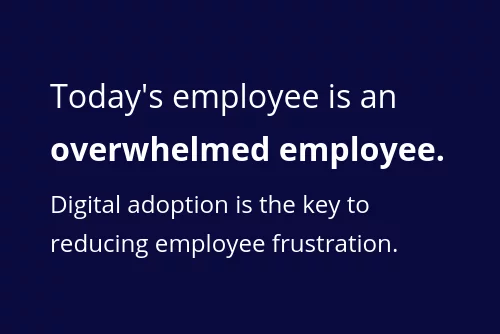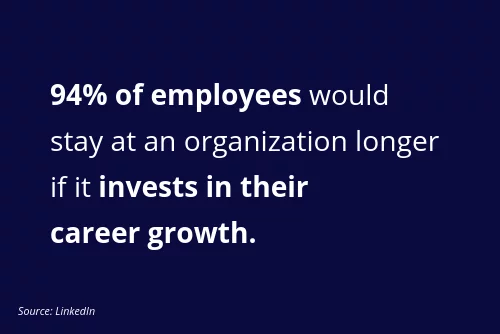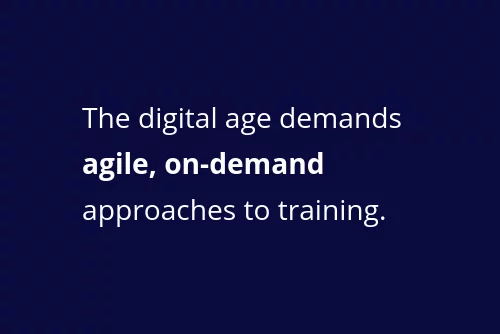Do you ever feel the need to make your employee training and development model more modern? Does your current approach feel outdated in a digital business environment?
If so, you’re probably right.
Today, digital technology is pushing every area of business forward — including the approach to employee training and development.
Below, we’ll cover a few improvements that can help you make your training programs more modern, more digital, and more successful.
Effective employee training and development is fundamental to business success
Training and development look quite different now than they did a few decades ago.
The introduction of new workplace technology, the subsequent demand for higher digital literacy, and the need for new employee skill sets mean companies must change their approach to training.
Training and development programs can’t be viewed as a side project or something to work on when there’s spare time. Effective training is critical for keeping employees motivated and productive.
For instance, a study by the National Center on Educational Quality of the Workforce found that when businesses provided 10% more training opportunitities, they realized an 8.6% gain in productivity.
Other studies have shown direct links between employee training and performance.
An effective, cutting-edge training program doesn’t just help your employees achieve personal growth, it enables your organization to achieve business success.
Dive Deeper: 5 Critical Employee Skills in the Digital Workplace
5 training improvements to fit the digital age
Below are five improvements that will help your training programs keep up with the digital curve.
1. Prioritize digital adoption.
The average employee is inundated with workplace systems and apps. 
Though overwhelming at times, it’s important to recognize a few things about the “ocean of apps” that we work in every day:
- Used correctly, software and apps drastically boost productivity
- Digital tools do have a learning curve
- At times employees can feel overwhelmed by ongoing digital transformation
- Apps aren’t going away
The solution for each of these is to prioritize digital adoption.
Design a digital adoption process that emphasizes the importance of high-level usability and quickly picking up new processes.
The result: shortened learning curves, higher productivity, and increased satisfaction.
2. Emphasize communication skills development.
The integration of digital technology in internal operations demands the development of new “hard” technical skills, but that doesn’t replace the need for “soft skills.”
Soft skills such as communication, collaboration, problem-solving, and decision making should account for an important part of the modern employee training curriculum.
Not only because we want our employees to be well-rounded, but because soft skills are important from a job development perspective.
Ask yourself if the following could fit into your training program:
- Public speaking
- Negotiation
- Conflict resolution
- Empathy and people-reading
An organization that cultivates such skills will run smoother, have a better work environment, and be more attractive to jobseekers in the marketplace.
3. Position training and development as a business imperative.
Training and development aren’t just for show. They have important, tangible benefits to the overall business performance. 
By clarifying these benefits to the senior leadership, you’ll have a much better chance of “selling” your training initiatives throughout all ranks of the organization.
When speaking to employees, emphasize the importance of professional development.
Naturally, your employees are interested in their own career development. So demonstrate the value of your program in light of its career-enhancing potential.
When speaking to leadership, emphasize its organizational benefits. Point out, for instance, that skilled employees are more engaged, productive, and loyal.
Show the ROI of training and leaders are likely to listen.
4. Focus on the learner by personalizing training.
Today, digital businesses recognize the value of user-centric business models.
And the reason is simple – people are the centers of their own worlds.
When you enter their world and put them first, they will learn more effectively and perform better.
When it comes to employee training, focus on:
Personal interests – Each learner has specific interests. They will be more engaged if their training focuses on their interests
Learning style – Some prefer watching videos, some prefer audio, some prefer reading, and some prefer doing – deliver content in multiple formats and let learners choose
Personal preferences – On top of learning modalities, consider other ways of personalizing training – time of day, location, group learning vs. self-learning, segmenting content for groups, and so on
This may seem like a lot to take on.
However, today’s most advanced training platforms make it easier than ever to personalize employee training.
5. Make training flexible, adaptable, and open.
In the digital age, more and more HR professionals are seeing the value of grabbing top talent when they have the opportunity … not waiting for a position to open. 
That means you need an employee training and development model that can be used on-demand.
If you rely exclusively on traditional, inflexible training methods – such as group orientations and training sessions – you could be drastically slowing down your new hire’s time to productivity, and also hurting their overall experience in the company.
Instead, take advantage of new technology to create open training solutions.
Create training programs that adapt to employees’ needs, rather than forcing them to adapt to an inflexible timeline. Offering extensive online elements through websites, learning platforms, etc., allows employees to train at their own time and pace.
Get digital, get results
Today’s employee works in an increasingly complex digital environment.
To keep up, HR must transform with digital technology, offer timely training, and personalized onboarding.
Keep up with today’s digital culture, and your training programs will get better results, improve productivity, and make employees happier.
________ WalkMe’s Digital Adoption Platform (DAP) transforms the user experience in today’s overwhelming digital world. Using artificial intelligence, engagement, guidance, and automation, WalkMe’s transparent overlay assists users to complete tasks easily within any enterprise software, mobile application or website. Discover how a DAP can revolutionize your business. — Request a demo today.

